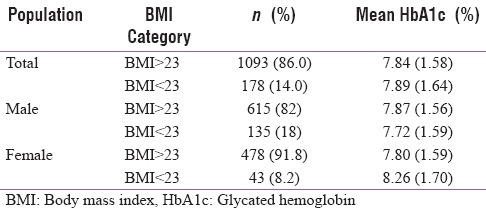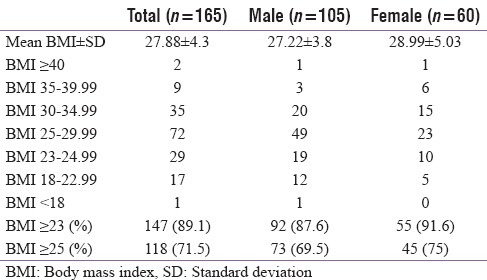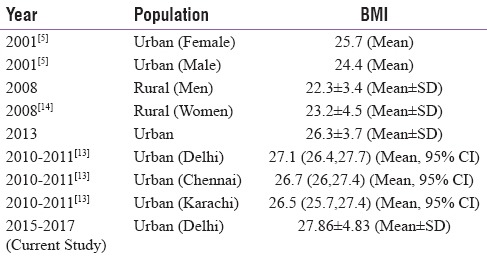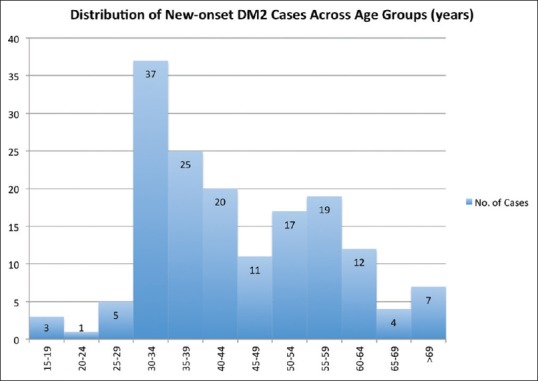Abstract
Context:
Indian population is known to develop diabetes at lower body mass index (BMI) and younger age than their western counterparts. However, data on the prevalence of overweight/obesity in people with diabetes have not been well documented in the Indian literature. The current study also establishes time trends for the age of onset of diabetes mellitus type 2 in Urban India.
Aims:
The aim of this study was to analyze the current trend in the presentation of people with diabetes in a metropolitan city (Urban residents) in context to age, sex, and BMI.
Settings and Design:
Retrospective cross-sectional study.
Subjects and Methods:
Data captured in clinic electronic medical records from May 2015 to March 2017 are analyzed. The profile of newly diagnosed diabetes is also presented.
Statistical Analysis Used:
Data were analyzed descriptively and for statistical analysis, SPSS software was used.
Results:
A total of 1473 patients with age 52.6 ± 12.7 (mean ± standard deviation) and BMI of 27.86 ± 4.83 kg/m2 were analyzed. About 17.6% were overweight; 71.5% were obese. The significant higher proportion of females was overweight/obese (91.2% vs. 82% of males; P < 0.0001). Females had significantly higher mean BMI than males (29.19 ± 4.99 vs. 26.93 ± 4.83; P ≤ 0.001). Overall, mean HbA1c of patients was 7.84% ±1.61% with no significant difference between genders. However, there was no difference in mean HbA1c based on either gender or BMI category. Among people with new-onset diabetes, there was even higher proportion of people with BMI ≥23 kg/m2 (overall 89.1%, males 87.6%, and females 91.6%). About 43.8% of people presented at <40 years age. Totally, 49.5% of males presented at age <40 years as compared to 33.9% of females.
Conclusions:
The prevalence of obesity among people with diabetes in Indian setting is now as high as in western studies. Indians are now presenting with diabetes at even earlier age with higher BMI.
Keywords: Age of onset, body mass index, diabetes mellitus, India, urban population
INTRODUCTION
Association between diabetes and obesity has always been known to vary as per different ethnicities. Indians are known to be prone to diabetes at lower body mass index (BMI) and also at much earlier age as compared to Caucasians.[1,2] India is, unfortunately, about to become diabetes capital of the world while it still has very low rates of obesity among the general population as compared to Europe and North America.[3] It is a common perception that people with diabetes in India are generally lean. There are numerous population-based studies documenting the occurrence of diabetes at much lower BMI in Indians.[4] However, studies documenting the actual prevalence of overweight/obesity among people with diabetes in India are scant or nonexistent. Current study fills this lacuna in literature.
Indians are also believed to have diabetes a decade earlier than Caucasians.[1] Several studies document the peak onset of diabetes among Indians at 40–49 years of age group.[5,6] The current study provides an insight into the temporal trend for age at onset of diabetes for Indian urban population.
SUBJECTS AND METHODS
Retrospective data from our clinic situated at a highly urbanized locality of New Delhi, India, were retrieved and analyzed. Most of the patients coming to clinic belong to upper middle socioeconomic strata and are highly educated. At the clinic, all patients are being given prescription using electronic medical software “Healthvriksh EMR, version 1 (Kalpavriksh Healthcare, Delhi, India)” since May 2015. This allows us to capture all clinical data longitudinally for all patients. Vital signs of all patients, including height and weight, are recorded at each clinic visit by our trained staff and entry is done in the electronic medical record (EMR) by the same person immediately. This minimizes the possibility of clerical errors in data. Height is measured using standard wall-mounted stadiometer. Weight is measured using an electronic weighing scale that is calibrated yearly by the competent external agency. Retrospective data of all patients with diabetes were captured from clinic EMR from May 2015 to March 2017 period and were analyzed. Data were analyzed descriptively to assess the prevalence of obesity and overweight among people presenting with diabetes at our center. BMI cutoff for overweight was kept at 23 kg/m2 and BMI ≥25 kg/m2 was classified as generalized obesity as per the accepted norms for the Indian population.[7,8] Further, subset analysis of people with new-onset diabetes was done. For statistical analysis, IBM SPSS Statistics for Windows, version 24 (IBM Corp., Armonk, NY, USA) was used.
RESULTS
Data of total 1473 patients were retrieved. Mean age of patients was 52.64 ± 12.66 years with mean BMI of 27.86 ± 4.83 kg/m2. Females had significantly higher mean BMI than males (29.19 ± 4.99 vs. 26.93 ± 4.83; P ≤ 0.001). Table 1 delineates basic demography of study population.
Table 1.
Demography of study population

Overall, 86% of all people with diabetes had BMI ≥23 kg/m2. Significantly higher proportions of females with diabetes had the prevalence of overweight/obesity as compared to males (91.8% vs. 82%; P ≤ 0.0001). However, there was no difference in mean HbA1c based on either gender or BMI category. Distribution of patient population according to overweight/obesity status and their HbA1c distribution is shown in Table 2.
Table 2.
Distribution of patient population according to overweight/obesity status and their glycated hemoglobin distribution

In comparison to the overall data, data of people with new-onset diabetes (n = 165) were even more startling with even higher proportion of people with BMI ≥23 (overall 89.1%, males 87.6%, and females 91.6%) [Table 3]. The difference was not significant statistically when the comparison was done between sexes.
Table 3.
Distribution of people with new-onset diabetes according to overweight/obesity status

Among this population, 47.2% of people presented at ≤40 years age. About 53.4% of males presented at age ≤40 years as compared to 30.9% of females. The proportion of people diagnosed at different age groups has been presented in image 1. Notably, the largest number of people is diagnosed between 30 and 35 years age group.
DISCUSSION
Traditionally, Indians have been considered to have higher insulin resistance and higher diabetes prevalence despite having low BMI population.[2] This has been explained on the basis of the higher amount of visceral fat as compared to Caucasians as well as due to the difference in adipocyte characteristics.[9,10] However, estimates of low BMI in Indians with diabetes have been based on decade-old data. The situation is perceived to be changing, especially in urban areas, with rapid increase in the prevalence of obesity.[11]
In fact, there is a paucity of data documenting the actual prevalence of different weight categories in people with diabetes. In population, as a whole, the prevalence of obesity in general is still low as compared to western countries, though it is increasing at rapid pace.[11] In a study by Ramachandran et al., 46.8% of people with diabetes had BMI more than 25 kg/m2 in 2001 from an urban population.[5] In ICMR-INDIAB 3 study, a survey done from 2008 to 2010 among mixed (rural as well as urban) population, 48.5% people with diabetes had BMI >25 kg/m2 as compared to 16.9% in people with normal glucose tolerance.[12] In contrast, the current study shows that 71.5% people with diabetes have same amount adiposity. Among Indians, predisposition at lower BMI and increasing adiposity may prove to be a double whammy for the prevalence of diabetes in the foreseeable future. This trend has been very well delineated in CAARS cohort, showing 25.2% prevalence of diabetes and 47.6% of prediabetes.[13]
Over the years, there are studies showing a gradual increase in the mean BMI of people suffering from diabetes [Table 4]. However, no study has tried to find the actual prevalence of overweight/obesity in people suffering from diabetes. Out dataset fills this lacuna in literature. However, these data are from the highly urbanized area of NCT of Delhi and may not represent Indian population in general. However, the strength of the study lies in fact that data have been recorded at the clinic by trained staff using calibrated instruments.
Table 4.
Indian studies documenting BMI in people with diabetes

Subset analysis of people with recent onset diabetes further strengthens the BMI data and confirms our worse fears.
Another frightening aspect brought to the notice is the highest incidence happening in 30–35 years age group followed by in 35–40 years [Figure 1]. Now, as much as 47.2% cases are reported at <40 years of age which is again way more than reported previously. In contrast, National urban diabetes survey (NUDS) in 2001 reported the highest prevalence of new-onset diabetes in the age group from 40 to 49 years.[5] Similar data were reported by Mohan et al. 5 years later in 2006 with maximum prevalence of diabetes onset in 40–49 years of age but slight temporal trends toward occurrence at a younger age as compared to NUDS.[6] Again urbanized nature of study population is to be considered, but even then it is bad forbearance for future as India is urbanizing at a rapid pace.
Figure 1.

Distribution of New Onset Diabetes Across Age-groups
The current study reports better glycemic control with mean HbA1c of 7.84 (1.61) as compared to other similar datasets. In a large population comprising 20,554 people with diabetes enrolled from all parts of India, average baseline HbA1c was reported to be 9.2%.[15] In another study, by Unnikrishnan et al., mean HbA1c varied from 8.0% to 9.1% from different parts of the country.[16]
CONCLUSIONS
The current study is one of the few studies, documenting the prevalence of overweight/obesity status among people with diabetes in India. Our data show that the prevalence of obesity among people with diabetes in Indian setting is now as high as in western studies. This could pose great management difficulties in the long-term management of these people. The current study also reveals the markedly younger age of onset of diabetes among people living in urban India.
Financial support and sponsorship
Nil.
Conflicts of interest
There are no conflicts of interest.
Acknowledgment
We greatly acknowledge Ankur Tiwari, Ankush Singla, Sakshi, and Vineet Kaur for their unending help in devising system for the collection of this data.
REFERENCES
- 1.Misra A, Khurana L. Obesity-related non-communicable diseases: South Asians vs white caucasians. Int J Obes (Lond) 2011;35:167–87. doi: 10.1038/ijo.2010.135. [DOI] [PubMed] [Google Scholar]
- 2.Gujral UP, Pradeepa R, Weber MB, Narayan KM, Mohan V. Type 2 diabetes in South Asians: Similarities and differences with white Caucasian and other populations. Ann N Y Acad Sci. 2013;1281:51–63. doi: 10.1111/j.1749-6632.2012.06838.x. [DOI] [PMC free article] [PubMed] [Google Scholar]
- 3.Yoon KH, Lee JH, Kim JW, Cho JH, Choi YH, Ko SH, et al. Epidemic obesity and type 2 diabetes in Asia. Lancet. 2006;368:1681–8. doi: 10.1016/S0140-6736(06)69703-1. [DOI] [PubMed] [Google Scholar]
- 4.Snehalatha C, Viswanathan V, Ramachandran A. Cutoff values for normal anthropometric variables in Asian Indian adults. Diabetes Care. 2003;26:1380–4. doi: 10.2337/diacare.26.5.1380. [DOI] [PubMed] [Google Scholar]
- 5.Ramachandran A, Snehalatha C, Kapur A, Vijay V, Mohan V, Das AK, et al. High prevalence of diabetes and impaired glucose tolerance in India: National urban diabetes survey. Diabetologia. 2001;44:1094–101. doi: 10.1007/s001250100627. [DOI] [PubMed] [Google Scholar]
- 6.Mohan V, Deepa M, Deepa R, Shanthirani CS, Farooq S, Ganesan A, et al. Secular trends in the prevalence of diabetes and impaired glucose tolerance in urban South India – The Chennai urban rural epidemiology study (CURES-17) Diabetologia. 2006;49:1175–8. doi: 10.1007/s00125-006-0219-2. [DOI] [PubMed] [Google Scholar]
- 7.Anjana RM, Deepa M, Pradeepa R, Mahanta J, Narain K, Das HK, et al. Prevalence of diabetes and prediabetes in 15 states of India: Results from the ICMR-INDIAB population-based cross-sectional study. Lancet Diabetes Endocrinol. 2017;5:585–96. doi: 10.1016/S2213-8587(17)30174-2. [DOI] [PubMed] [Google Scholar]
- 8.Misra A, Chowbey P, Makkar BM, Vikram NK, Wasir JS, Chadha D, et al. Consensus statement for diagnosis of obesity, abdominal obesity and the metabolic syndrome for Asian Indians and recommendations for physical activity, medical and surgical management. J Assoc Physicians India. 2009;57:163–70. [PubMed] [Google Scholar]
- 9.Anand SS, Tarnopolsky MA, Rashid S, Schulze KM, Desai D, Mente A, et al. Adipocyte hypertrophy, fatty liver and metabolic risk factors in South Asians: The molecular study of health and risk in ethnic groups (mol-SHARE) PLoS One. 2011;6:e22112. doi: 10.1371/journal.pone.0022112. [DOI] [PMC free article] [PubMed] [Google Scholar]
- 10.Bakker LE, Sleddering MA, Schoones JW, Meinders AE, Jazet IM. Pathogenesis of type 2 diabetes in South Asians. Eur J Endocrinol. 2013;169:R99–114. doi: 10.1530/EJE-13-0307. [DOI] [PubMed] [Google Scholar]
- 11.National Family Health Survey. Mumbai: c2009. [Last accessed on 2017 Oct 02]. Available from: http://www.rchiips.org/NFHS/pdf/NFHS4/India.pdf . [Google Scholar]
- 12.Pradeepa R, Anjana RM, Joshi SR, Bhansali A, Deepa M, Joshi PP, et al. Prevalence of generalized and abdominal obesity in urban & rural India – The ICMR-INDIAB study (Phase-I) [ICMR- NDIAB-3] Indian J Med Res. 2015;142:139–50. doi: 10.4103/0971-5916.164234. [DOI] [PMC free article] [PubMed] [Google Scholar]
- 13.Deepa M, Grace M, Binukumar B, Pradeepa R, Roopa S, Khan HM, et al. High burden of prediabetes and diabetes in three large cities in South Asia: The center for cArdio-metabolic risk reduction in South Asia (CARRS) study. Diabetes Res Clin Pract. 2015;110:172–82. doi: 10.1016/j.diabres.2015.09.005. [DOI] [PMC free article] [PubMed] [Google Scholar]
- 14.Ramachandran A, Snehalatha C, Baskar AD, Mary S, Kumar CK, Selvam S, et al. Temporal changes in prevalence of diabetes and impaired glucose tolerance associated with lifestyle transition occurring in the rural population in India. Diabetologia. 2004;47:860–5. doi: 10.1007/s00125-004-1387-6. [DOI] [PubMed] [Google Scholar]
- 15.Mohan V, Shah S, Saboo B. Current glycemic status and diabetes related complications among type 2 diabetes patients in India: Data from the A1chieve study. J Assoc Physicians India. 2013;61:12–5. [PubMed] [Google Scholar]
- 16.Unnikrishnan R, Anjana RM, Deepa M, Pradeepa R, Joshi SR, Bhansali A, et al. Glycemic control among individuals with self-reported diabetes in India – The ICMR-INDIAB study. Diabetes Technol Ther. 2014;16:596–603. doi: 10.1089/dia.2014.0018. [DOI] [PMC free article] [PubMed] [Google Scholar]


